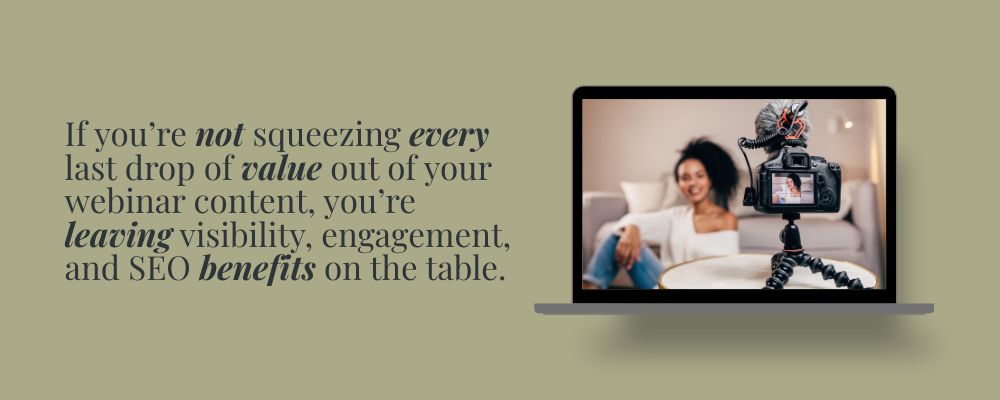Webinars take effort. You’ve got invites to send, speakers to wrangle, slides to prepare, tech to test, comms to coordinate… it’s a lot. So why let all that work stop at the 45-minute mark?
If you’re not squeezing every last drop of value out of your webinar content, you’re leaving visibility, engagement, and SEO benefits on the table. Here’s how we’d take a single webinar and turn it into a whole month’s worth of content, using our own workflow, and a few favourite tools (plus a little bit of AI, but not too much, we’re not handing over the reins entirely).
First: Why Bother?
Apart from making your content calendar a whole lot easier to fill, repurposing webinar content has some sneaky side benefits:
- It shows off the quality of your events.
- It creates a sense of FOMO (in a good way) for people who didn’t attend.
- It keeps the conversation going long after the event ends.
- It helps promote future webinars (because no one wants to be the person who misses out twice).
And if you’re doing a series of webinars, all the more reason to keep the content flowing in between sessions.

Step 1: Get the Transcript
Drop your webinar recording into otter.ai and let it generate a full transcript. It won’t be perfect, but it’s a start.
Step 2: Pull Out the Gold
Take that transcript and upload it to ChatGPT. Ask it for 5–10 key takeaways. These are your big ideas or concepts from the webinar – whatever made the session valuable.
Bonus: Ask it to also pull 5–10 great one-liner quotes or snap takeaways. Think short, punchy, two-sentence max – the kind of stuff that makes for a good pull-quote graphic.
Step 3: Write Two Blog Articles
You’re going to end up with:
Blog 1: Top Takeaways
Title something like: “10 Things We Learned from Our Webinar on [Topic]”. Flesh out the takeaways into a proper article. You can use ChatGPT to get started, but then edit it to sound like you (because no one likes reading obvious AI copy). Add a CTA at the bottom to read the full transcript or watch the whole session.
Blog 2: Full Transcript + Recording
Clean up the transcript (ask ChatGPT to tidy up sentence structure and remove ums/ahs) and publish it alongside the embedded video. This becomes your evergreen resource.
Link the two articles together with CTAs: one for the highlights, one for the full thing.
Related reading: How we managed a full-service webinar campaign for a financial services client
Step 4: Spin It Into Social Posts
From those takeaways, quotes, and transcript sections, you’ve now got:
- 10 social posts from your takeaways blog (one per takeaway)
- 1 post linking to the full webinar recording
- 4–6 pull-quote graphics (text-based posts or images)
- 3–5 short video snippets (we’ll get to that next)
Total: ~15–20 social posts, minimum.
Create a branded tile template for consistency and schedule them out over 2–4 weeks. And don’t forget to tag your speakers – they’ve already said yes to being in the webinar, they’ll likely be happy to engage with the posts too.
Step 5: Cut the Video
Now you’ve got the transcript – use it to pinpoint 1–2 minute clips that can stand alone. These are your teaser videos. Use tools like Canva or CapCut to edit them down, add captions (always), and pop in a call to action to view the full recording.
Pro tip: Look for any audience Q&A moments – each of these is gold. If someone asked a great question, it probably reflects something your broader audience is wondering too. Just make sure you have their permission before posting their video segment, or turn it into another text-and-image based post.
Step 6: Create Carousels
Take those 10 takeaways again and make a carousel (LinkedIn, Insta, or wherever you’re active). Each slide = one point. Add a final slide with a CTA to read the blog.
That’s another post (or three, if you want to break them into smaller sets).
Step 7: Future-Proof the Flow
Got another webinar coming up?
- Go back to your full transcript blog and add a CTA like “Don’t miss our next one! [Register here]”
- On your new event promo blog, add a “Catch up on our last webinar” section that links back to the previous session.
This creates a nice little content loop where every event helps fuel the next.
Wrap-Up (TL;DR version)
📄 2 blog articles
📱 15–20+ social posts
🎥 4–6 short-form videos
📚 1–2 carousels
📈 Endless opportunities to repurpose, cross-promote, and keep your content calendar full.
All of this not only helps you milk your webinar for content, but it also reinforces your expertise, improve your SEO, and build a sense of momentum for your future events. And if all that sounds like too much to do solo, well…
Need help turning your webinars into marketing fuel? We’ve got the tools, the templates, and the team to make it easy. Let’s chat.



